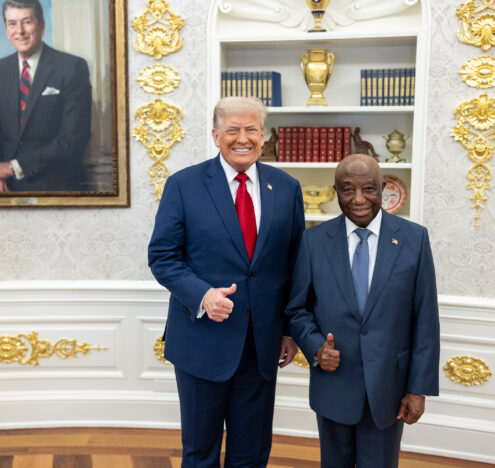On Jun. 26, 2020, members of the Jalisco New Generation Cartel when to Mexico City and attempted an assassination on the capital’s policy chief. They killed two police and a civilian as well as wounding the police chief. They were armed with US-made rifles and ammunition.
This is not an unusual story. Whether it is the Biden administration recently authorizing hundreds of millions of dollars of these weapons to Ukraine (where there is a history of losing these arms) or Mexico, where US firearms contributed to 24,617 homicides in 2020, these weapons are initially sold, dispersed by choice or violence, and then used to violate human rights and sow instability.
In Mexico, US-made small arms and light weapons make up the majority of firearms found at crime scenes in the country. Likewise, in Central America’s Northern Triangle, 40% of recovered, loose firearms came are from the US — and almost half of these were not via legitimate commerce.
WHY SELLING ARMS IS COSTLY
In a recent study for the Cato Institute, we expand on previous work that traces the risk of Washington’s weapon sales. We find that the US sold small arms and light weapons to 167 countries and that these sales account for roughly 17.5% of the $1.3 trillion in US arms sales authorizations since 2009. The biggest customers for US small arms and light weapons include safer US allies and partners, such as Japan and South Korea, but also riskier ones, including Turkey, Egypt, Singapore, and Colombia. It is the latter group of countries where end-use monitoring is weakest and the risks are greatest.
We identify three major costs associated with US policy toward small arms and light weapons. The first is that these sales empower authoritarianism and threaten liberty. At worst, by selling weapons to governments that choose to harm their citizens, the state gains the ability to respond to any instance of unrest or political change with immense violence. This is the case in the Philippines, where the government has used its US-armed police forces to commit heinous violence against its citizens. In 2020, at the outset of the COVID-19 pandemic, the Duterte government instituted severe lockdowns that resulted in arrests and murders of political opposition under the auspices of the regime’s “anti-drug campaign.”
In instances without clear state violence against citizens, selling small arms and light weapons to authoritarian leaders still can cause harm by increasing corruption. For example, the US has authorized over $18 billion in weapons sales to Mexico between 2009 and 2013, and over 32% of those sales were small arms and light weapons. These weapons went toward the Mexican military and police forces. Unfortunately, the International Crisis Group has reports from 2018 and 2020 that identify Mexican police engaging in illicit behavior and using their weaponry to commit their own crimes.
US arms sales empower anti-democratic leaders, lead to violence against innocent civilians and US soldiers, and cost US taxpayers millions of dollars when a clean-up is needed.
The second cost is that criminal organizations seize lost small arms and light weapons. This is a result of poor enforcement policies. The US has not ratified the Arms Trade Treaty, which has shown modest success at reducing illegal weapons dispersion. The Leahy Laws try to prevent US security aid from ending up in the wrong hands, but problems exist. They do not apply to civilian harm in conflict, are reliant on human rights information in unstable countries, and only take effect after human rights abuse have occurred. US end-use monitoring laws have similar problems. For example, Blue Lantern laws attempt to meet requirements ensuring that US direct commercial sales are compliant with US government standards about the use, transfer, and security of defense articles and services. Unfortunately, only 1% of total license applications lead to a Blue Lantern check and 25% of these checks result in an “unfavorable” finding.
Making matters worse is that the US sells small arms and light weapons to fragile countries. Twenty-nine countries in the Arms Sales Risk Index fall into the Fragile States Index “Alert” category of the most fragile states, but the US has sold $15 billion worth of weapons, including many small arms and light weapons, to them since 2009. As a result, US efforts to regulate the security of small arm transfers will fail. The lack of political will and adequate legal and bureaucratic capacity to enforce these transfers means that sales often end up in the wrong hands.
In Mexico, the US plays an even graver role. Legally owning a handgun in Mexico is difficult and dispersion is not occurring because of a long-standing civil war. Only one gun store exists in the country, and it is run by the Mexican Army. It only sells 38 firearms per day, and the legal requirements to own those guns are exceedingly high. Yet, 70% of firearms recovered from gangs in Mexico were American. Central America is no better. In El Salvador, over 92% of lost firearms were US-made, and were “lost” after the initial transfer. The US Bureau of Alcohol, Tobacco, Firearms, and Explosives finds similar problems in the larger region. In Belize, El Salvador, Guatemala, and Honduras combined, 42% of US firearms are tracked, but the initial purchaser is unknown.
The final cost is this: Sales of small arms and light weapons lead to increases in organized violence. Research finds that increasing flows of small arms into a country lead to increased homicide rates, with the effect most pronounced in nations with low state capacity. This is likely because the weapons are getting dispersed to violent organizations without any state monitoring. Over 65% of crimes in Mexico between 2011–2013 and 56% of homicides between 2013–2016 used US weapons. In the Philippines, Papua New Guinea, and Nigeria, these weapons have empowered gangs. Throughout the Global War on Terror in Afghanistan and the Middle East, these weapons have aided terrorist attacks against the US.
In response, recipient countries ask for US aid to address these problems. As a result, the US spent over $38 million between 2015–2019 helping to disrupt this firearm tracking in Central America. The costs to taxpayers from these small arms and light weapon sales, however, should make policymakers think twice before touting the economic benefits to such a policy.
A CALL TO ACTION
The US can — and should — address these problems. For example, the US could consider ratifying the Arms Trade Treaty. The Arms Trade Treaty has been enforced globally since 2014. Despite signing it, the US never ratified the treaty. Moreover, former President Donald Trump announced that he would “unsign” the treaty.
The Arms Trade Treaty has proven to be an effective, albeit imperfect, mechanism for reducing problems with the small arms trade. The treaty provides states with tools to prevent weapons from ending up in the hands of war criminals as well as creating risk assessment measures so member states can avoid illegal trade of their weapons. Data exists to support the treaty’s positive impact on enhancing transparency over the global arms trade. The Stimson Center found that compliance with the treaty has averaged around 69% over the last six years and that 2020 saw a 6%-point increase in reporting states parties since 2019. Yet, beyond political handwaving, the Biden administration has shown little interest in ratifying the treaty.
The US also could work on existing legislation like the Safeguarding Human Rights in Arms Exports Act of 2021 that empowers agencies to focus on human rights in the arms sales process. Relatedly, policymakers could reconsider Trump’s transition of small arm and light weapons sales to the Department of Commerce and move it back to the State Department. Yet, in both situations, there is no real push from the executive branch or any legislators to successfully push through these changes.
Overall, these sales empower anti-democratic leaders, lead to violence against innocent civilians and US soldiers, and cost US taxpayers millions of dollars when a clean-up is needed. There are currently options available to policymakers that could address some of these consequences. Unfortunately, the political will to invest in these options is, at best, limited.
Jordan Cohen is a Policy Analyst in Defense and Foreign Policy Studies at the Cato Institute and a PhD candidate in political science at the Schar School of Policy and Government at George Mason University.
Trevor Thrall is associate professor at the Schar School of Policy & Government at George Mason University and senior fellow at Cato Institute’s Defense and Foreign Policy Studies department.




















